I, as an engineer, am born with a genetic defect….as all engineers are…the “efficiency gene”. We can’t help ourselves. The more efficient a thing is…the better it is…in our engineering brains….I love thermal resistance. I love insulation. I love all insulations…fiberglass, cellulose, mineral wool, expanded polystyrene, extruded polystyrene, polyisocyanurate, low density spray foam, high density spray foam, phenolic insulation2.
Every now and then something gets to me. Actually, a couple of things. Here goes. We are going through a bunch of significant fundamental changes in the way we build buildings. We are supposedly getting serious about energy efficiency. I go and visit the local construction supply outlet and make the mistake of reading what is being sold. Ouch. For the record, radiant barriers do not have R-value. There is no such thing as R-11 radiant barrier paint. There is no such thing as R-4 3/8 inch thick bubble wrap reflective insulation under a concrete slab. There is no such thing as R- 4 1/4 inch thick bubble wrap reflective insulation on a duct. There is no such thing as R-50 1/16 inch reflective plaster3. There is more4.
And there is still more. Thermal mass is not very good thermal resistance unless you have reliable diurnal temperature swings and effective coupling to the enclosure5. Let me remind you youngsters….”light and tight” beat “mass and glass”. “Mass and glass” referred to masonry and stone exterior walls that were externally insulated. The mass was the masonry or stone. The glass was hugely thermally inefficient south facing almost entirely glass window walls. The idea was that solar radiation collection was maximized with lots of south facing glass and this solar energy was stored in the interior masonry and stone. Note that when I was a youngster I did mass and glass…yup, I got sucked in…now I am older and wiser and embarrassed. See Photograph 1 and Photograph 2…two “mass and glass” houses I built in 1980. I even did the R-15 “reflective insulation roll blinds” on the inside of the windows (Photograph 3). “Light and tight” meant extremely well insulated wood frame walls in a building that was significantly airtight. How many folks remember the Illinois Lo-Cal House and the Leger House (yes we were here before…”Building America”, ASHRAE Journal, December 2008)? GM-0802: BSC Building America Quality Control Checklist?
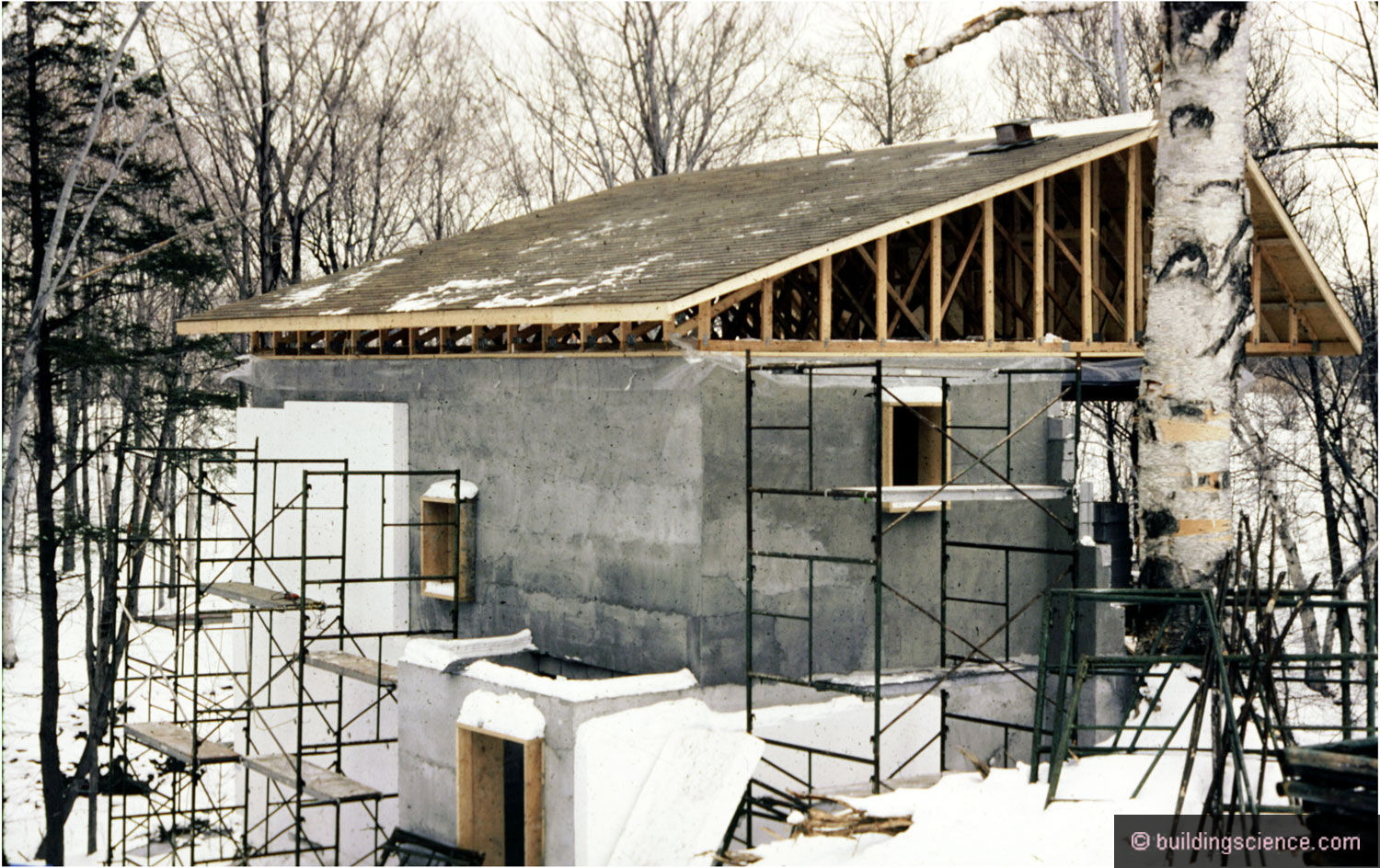
Photograph 1: Mass and Glass – A concrete block wall insulated on the exterior with 6 inches of expanded polystyrene. Note the “high heel” roof trusses so that ceiling insulation does not get “squeezed” at the perimeter. Yup, I did a few things correctly.
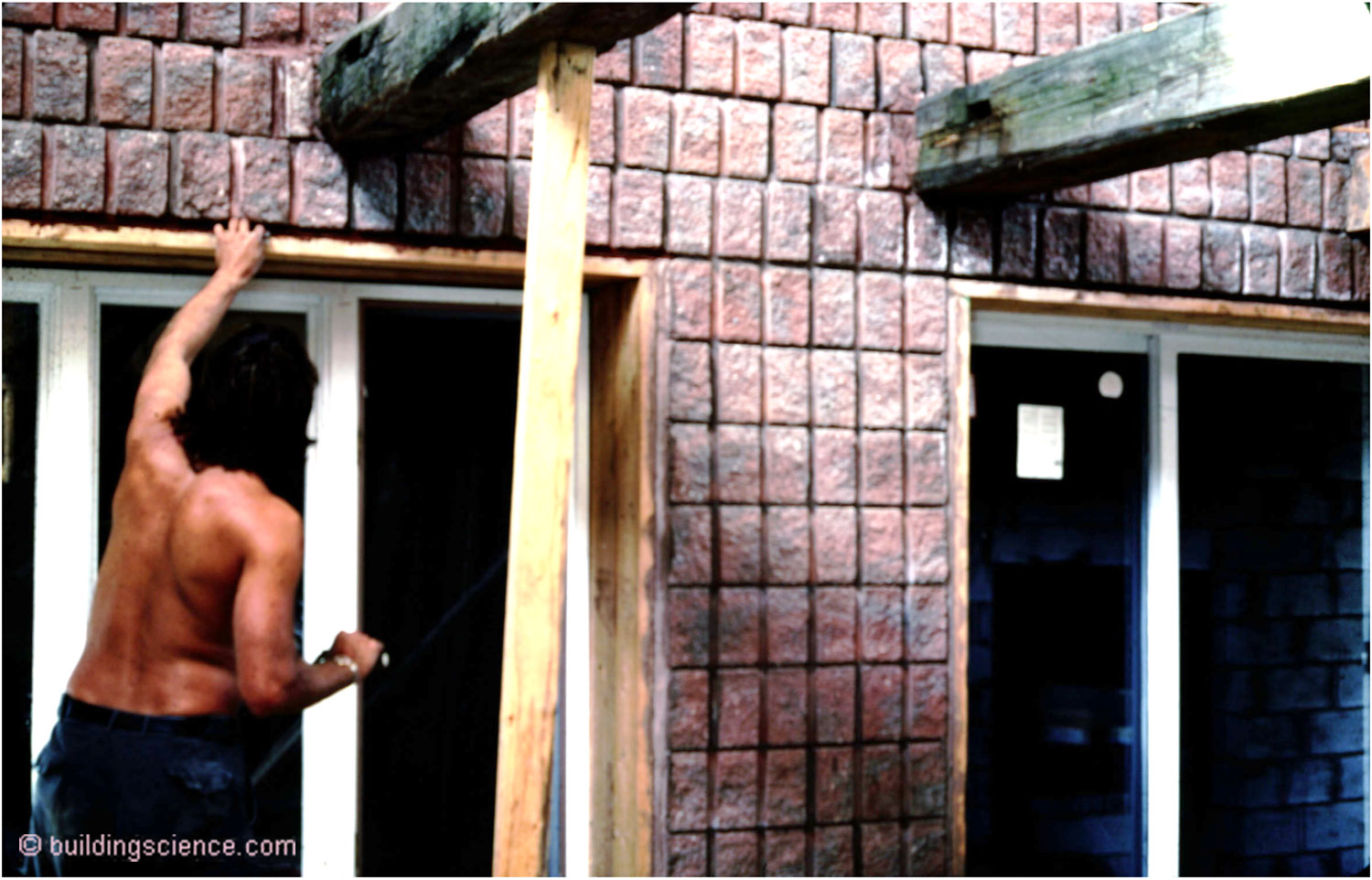
Photograph 2: Exposed and Coupled Interior Thermal Mass – Looks pretty good. Very expensive. Only the main floor thermal mass was coupled and distributed to the inside and solar gain. But, all the “light and tight” super insulated frame buildings I did later worked better and were much less expensive.
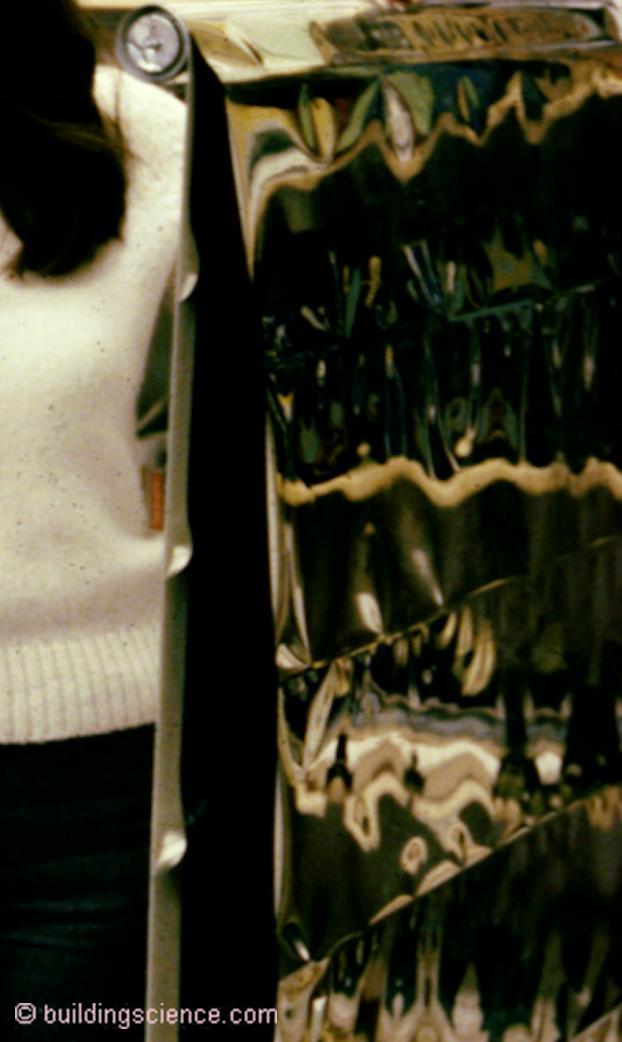
Photograph 3: Reflective Insulation Roll Blinds - The blinds 4 layers expanded as they were pulled down creating 4 airspaces each about 1 inch deep. Unfortunately there was no practical way of air sealing the airspaces. R-15 sounded great to me. I was young. Queen had a hit song “Another One Bites the Dust”. I didn’t realize it was about the thermal performance of the roll blinds.
And still more. Radiant barriers in attics only work well in poorly insulated attics. Read on. Yup, still more. Reflective insulation never worked on the inside of block walls in Florida6.
So what is radiant barrier paint? There is no such thing. A radiant barrier is a low-emittance (“low E”) surface facing an air space or vacuum. The American Society of Testing and Materials (ASTM) actually defines these things. ASTM defines radiant barriers as a material or layer that has a reflective/low-emittance of 0.10 or less (ASTM C1313-19)…there are interior radiation control coatings (IRCC)…but no radiant barrier paints. The applicable ASTM standard for measuring emittance is C1371-15 Standard Test Method for Determination of Emittance of Materials Near Room Temperature Using Portable Emissometers.
Recall the Stefan-Boltzmann Law and the fourth power of the thermodynamic temperature thing…if you want a radiant barrier to do anything it should be on the high temperature side of things…and it needs to face an “open” airspace…Wait for it…if there is no airspace and the radiant barrier is touching something…we call it conduction…not radiation anymore…no more radiant barrier. Radiant barriers do not have R-values…I think I already mentioned that…they only deal with radiation. R-values deal with conduction (and sometimes convection… they should always deal with convection…but that is for a different story and different time…).
So radiant barriers don’t make sense on the inside of a wall or on the inside of a roof or ceiling under insulation because those locations are not on the high temperature side of things or the real cold side of things. They certainly don’t make any sense under a floor slab or in crawl space floor framing…the ground isn’t that hot or that cold…the floor isn’t that hot or that cold…who knew?
So what is reflective bubble wrap? It is a roll product with sealed air bubbles between two layers of plastic or aluminum foil (Photograph 4). It is reflective insulation. Reflective insulation is different from radiant barriers. Reflective insulation relies on enclosed air spaces to have any benefit. It is typically between 1/4 inch and 3/8 inch thick…with claims that it has a thermal resistance of anywhere between R-4 and R-6. Think of the possibilities…you could take 4 layers of the R-6 bubble wrap – with the right air gaps - and wrap a R-13 cavity insulated wood frame wall and add an additional R-24 …awesome an R-40ish wall. Hey, Passive House folks, you catching this? And the cost is way less than adding 5 inches of extruded polystyrene or 3.5 inches of polyisocyanurate. What a bunch of losers we old engineers are.
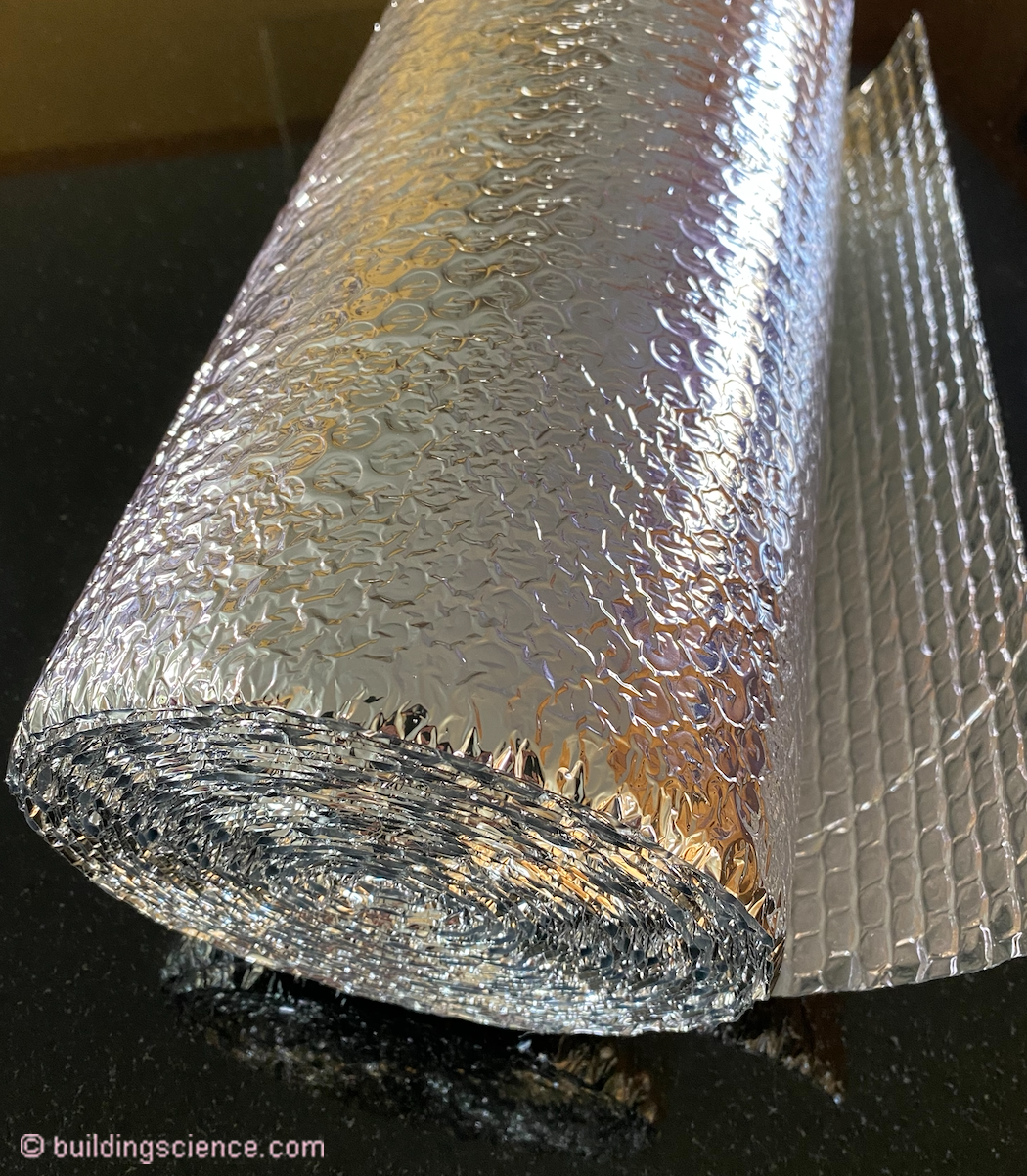
Photograph 4: Reflective Insulation - Reflective insulation is different from radiant barriers. Reflective insulation relies on enclosed air spaces to have any benefit.
Didn’t Lt. Commander Montgomery Scott (“Scotty”) invent “transparent aluminum in StarTrek IV? Actually we do have a version of transparent aluminum today…the “low E” coatings on insulated glass assemblies. But work with me on this. We could replace the aluminum foil layers in the 3/8 inch bubble wrap with transparent aluminum and attach the bubble wrap to glass windows – with the appropriate air gap and get an additional R-6. Excuse me a minute while I connect with the Patent Office.
Hate to burst everyone’s bubble….pun intended…National Resources Canada (NRCan) noted that Canada Mortgage and Housing Corporation (CMHC) performed studies on reflective films such as “foil-embedded bubble insulation and found that the actual thermal resistance is “R-1.5 where the bubble layer is between two layers of foil without air spaces in front of the foil” (NRCan, 2007). This was done with “real thermal performance testing”…“hot box testing” (ASTM C1363-19 – Standard Test Method for Thermal Performance of Building Materials and Envelope Assemblies by Means of a Hot Box Apparatus). Folks in Canada were using bubble wrap under concrete floor slabs arguing that the bubble wrap met the Canadian Code required R-5 slab insulation requirement…probably Hab’s fans….
The United States Environmental Protection Agency (EPA), take note Canadians…sometimes the US is on the same side as you…unequivocally stated in 2012 “radiant barrier products, as defined by EPA in the Seal and Insulate with Energy Star Definitions and Testing Requirements Version 1.0, are not included as a home insulation product in the Federal Trade Commission (FTC) Code of Federal Regulation (CFR) Part 460 ‘Labeling and Advertising Home Insulation.'” Radiant barriers do not have R-values…I think I already mentioned that…they are not insulation.
So what is going on? What is real and what is not real? Folks did a bunch of studies on radiant barriers in attics (Photograph 5) in the 1980’s. Two notable papers from Oak Ridge National Laboratory (Levins and Karnitz; 1987, 1988) showed that once attic insulation goes above R-30 radiant barriers provide little or no benefit. Note that the current International Energy Conservation Code calls for minimum attic thermal resistance of between R-38 and R-60.
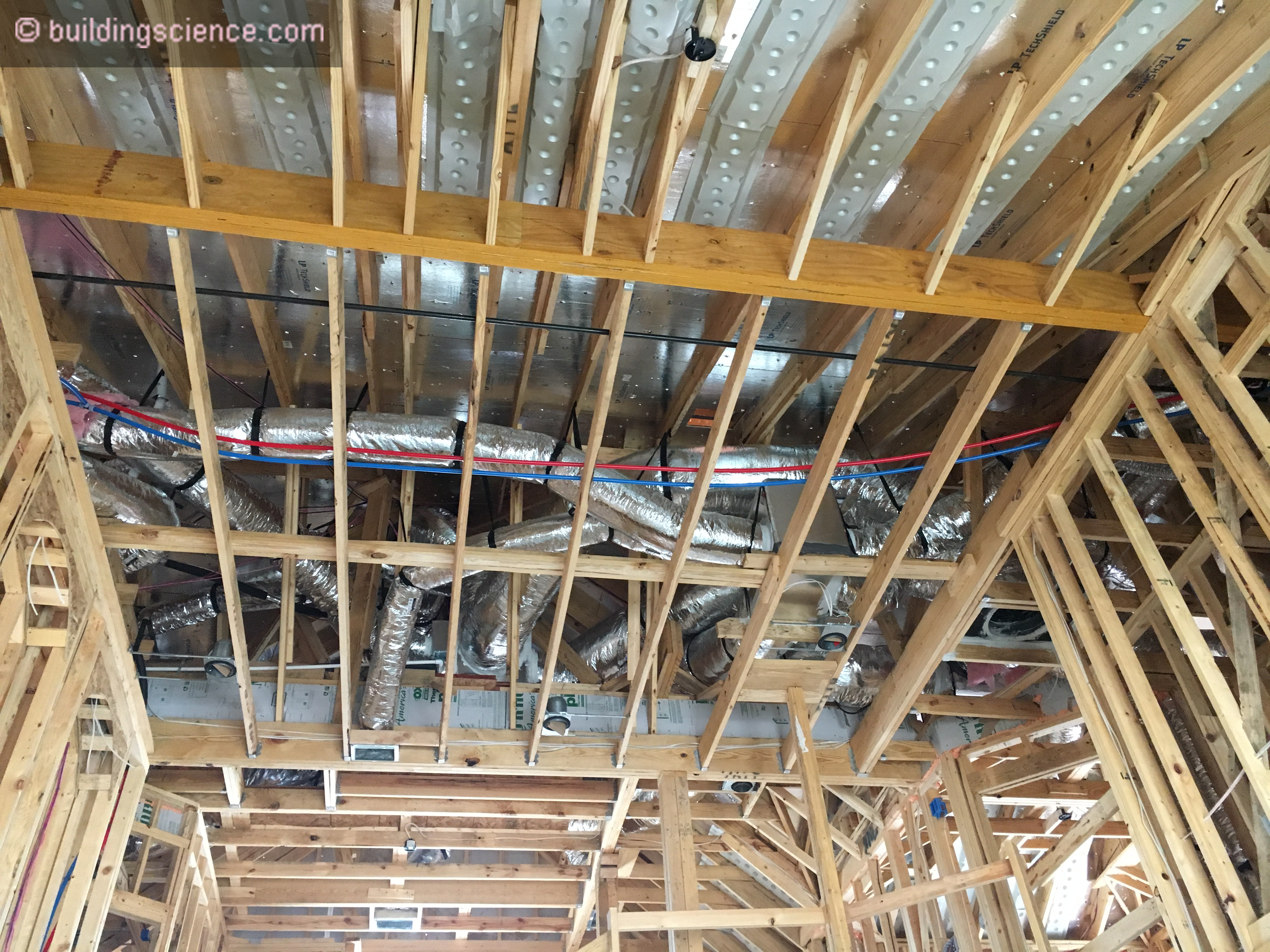
Photograph 5: Radiant Barrier in Attic - Once attic insulation goes above R-30 radiant barriers provide little or no benefit. Note that the current International Energy Conservation Code calls for minimum attic thermal resistance of between R-38 and R-60.
In an attic we have radiant energy transfer, conductive energy transfer and convective energy transfer. A radiant barrier on the underside of the roof sheathing only affects the radiant energy transfer…the air in the attic is still hot or cold depending on winter or summer and the attic air temperature is very much influenced by the outdoor air temperature and the amount of insulation…or lack of insulation on the ceiling…and, yes, the attic air moves around and that affects convective energy transfer.
Let’s talk about the color of roof membranes and roof shingles. Doesn’t this affect radiation? Yes. Lighter colored roof membranes are much cooler during the summer and not as affected by this thermonuclear ball of energy 93 million miles away called the sun…Isn’t this good? Yes, especially for the life of the membrane. Recall, the Arrhenius equation…every 20 degree F increase in average temperature reduces the life of the material by 50 percent….So the membranes last much longer…yeah…but what about that energy efficiency thing…not so much with the high levels of thermal insulation. So, yes, I like cool roofs…because things last longer…but I also like lots of insulation….
What about walls? I like white paint and light colored paints on claddings because the coatings last much longer. Unfortunately, they reduce drying potentials because they don’t get as hot and that can be an issue sometimes…but on the other hand they reduce inward thermally driven moisture out of reservoir claddings…yeah… So, what should I do on a wall? Insulate the heck out of it on the outside, provide water and air control layers, drain and back ventilate the cladding and color and radiation does not matter.
How about aluminum foil on the exterior face of that rigid continuous insulation (Photograph 6)? It is on the high temperature side of the assembly…so that is good for the radiation thing? Yes. And it faces an air gap…that cleverly located drainage gap behind the cladding…so that works. Yes. But walls don’t get as hot as roofs and walls are really well insulated now - R-20 to R-30 or more…so the radiation thing is kind of a bust. It gets worse. For the air gap to work to increase thermal resistance it needs to be “airtight” and be small enough to not have convective loops. Recall how windows work. Once you get more than a 1/2 inch airspace, window R-value is affected. And, isn’t the point of the air gap behind the cladding to provide “back ventilation” to promote drying? That makes the “airtight” thing go out the window…pun intended. But what I like about the aluminum foil is that it is a great water control layer, air control layer and vapor control layer. It also gives a big boost to the structural integrity of the rigid continuous insulation. So yeah to all that….but to say it gives a big boost to wall assembly R-value…slim to none…and Slim just left town….
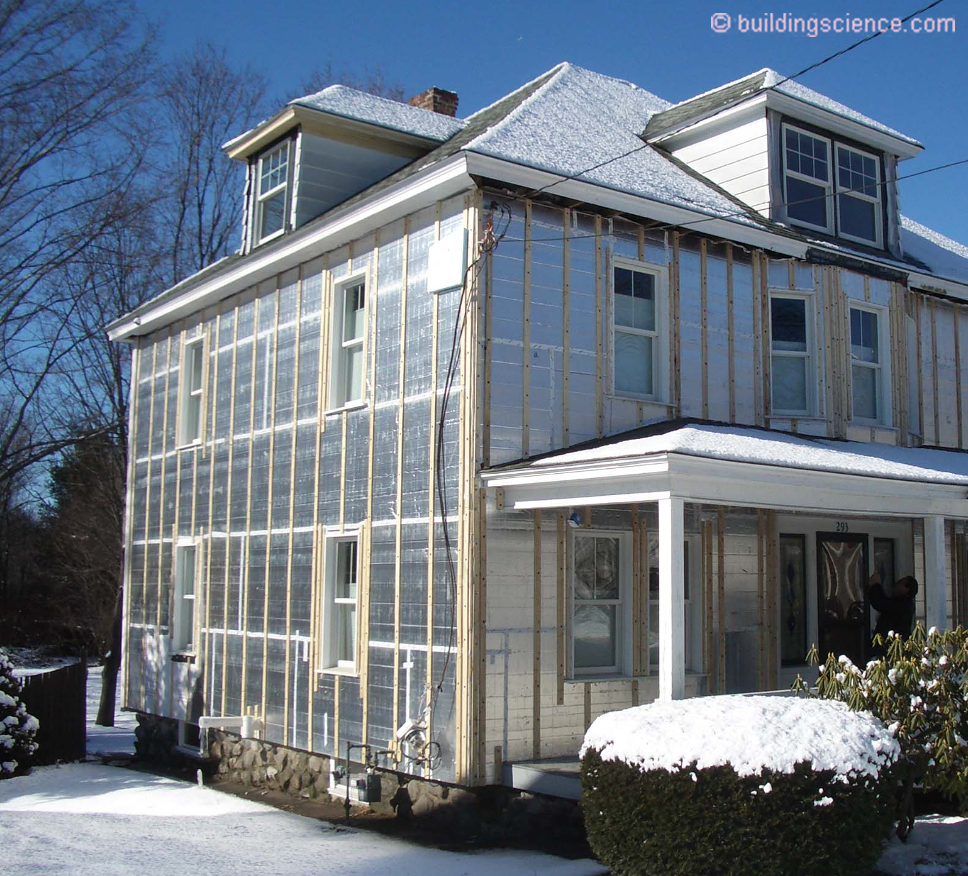
Photograph 6: Exterior Aluminum Foil - What I like about the aluminum foil on the exterior face of the exterior continuous rigid insulation is that it is a great water control layer, air control layer and vapor control layer. It also gives a big boost to the structural integrity of the rigid continuous insulation. So yeah to all that…but to say it gives a big boost to wall assembly R-value…slim to none….
What about that aluminum foil (aka “reflective insulation”) on the inside of batt insulation (Photograph 7)? Nope, not a radiant barrier…a vapor barrier…big difference…and the aluminum foil layer touches the interior wall lining, no airspace…unless there is really, really bad workmanship.
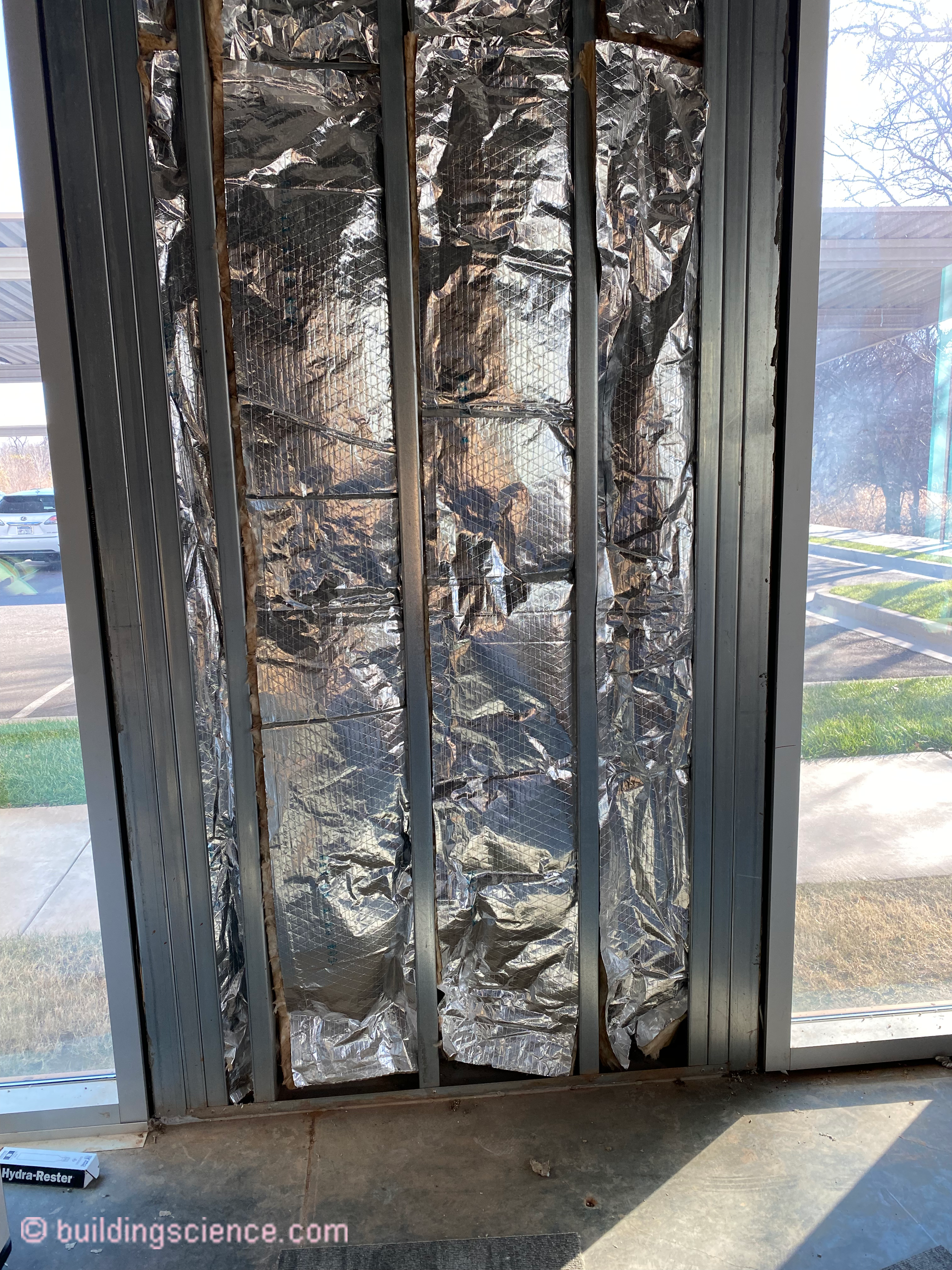
Photograph 7: Aluminum Foil on Cavity Insulation - aka “reflective insulation” on the inside of batt insulation? Nope, not a radiant barrier…a vapor barrier.
How about aluminum foil on the back side of the gypsum board? Nope, again, not a radiant barrier…a vapor barrier.
Let’s look at what was probably one of the worst attempted applications for reflective insulation…adding aluminum foil to the inside of a block wall in Florida (Photograph 8). It was installed over 3/4 inch wood furring with the foil facing the airspace. There was no real significant temperature difference between the interior gypsum board and the interior surface of the block wall. It was never, ever R-4 as claimed…actually the claim was “equivalent to R-4. No harm, no foul. No big deal. Nope. Big harm, big foul. The aluminum foil turned out to be a vapor barrier on the wrong side of the wall. Mold city. Perforating the aluminum didn’t help much…it was a Fick’s Law thing. So not only was the thermal performance bad but buildings became trashed.
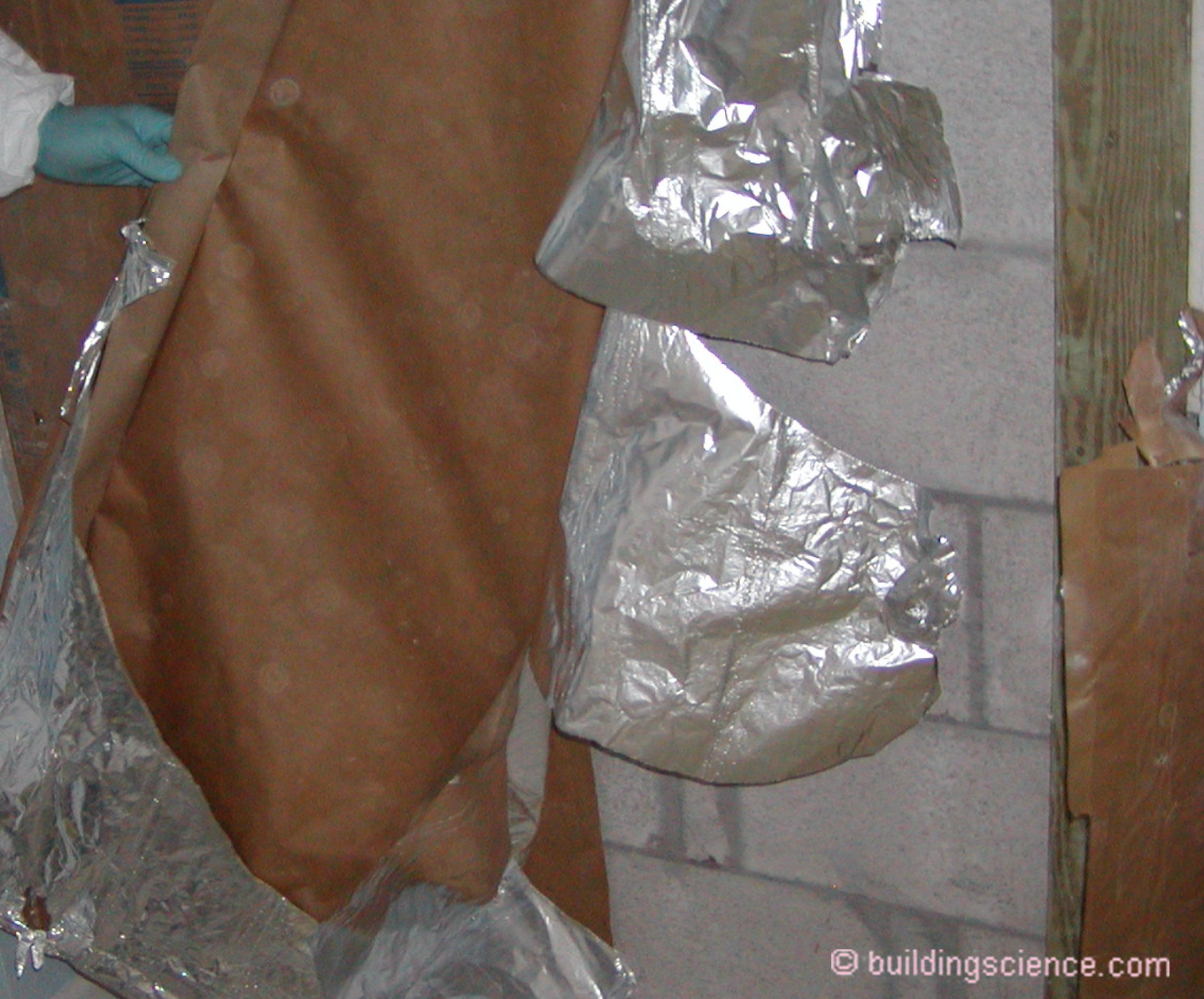
Photograph 8: Aluminum Foil on the Inside of a Block Wall in Florida – The “reflective insulation” was installed over 3/4 inch wood furring with the foil facing the airspace. The aluminum foil turned out to be a vapor barrier on the wrong side of the wall. Mold city.
Let’s look at the thermal mass thing….We learned a bunch of things in the 1970’s and 1980’s with thermal mass. Wait for it…thermal mass is not insulation…it just stores and releases energy. For it to be effective you have to get the energy into the thermal mass and you have to get the energy out of the thermal mass. The thermal mass needed to be distributed and only the first 1 inch of mass was useful. And you needed to insulate the outside of it…a lot…(yes, we were here before… BSI-065: But I Was So Much Younger Then, February 2013). You couldn’t count the thermal temperature swings – energy into the thermal mass and energy out of the thermal mass - as effective insulation. The temperature swings had to be reliable.
Remember MIT Solar V? It used “high tech thermal mass” - phase change ceiling tiles to store solar heat reflected sunlight passing through windows by interior venetian blinds with mirrored upper surfaces. The ceiling tiles had a sodium sulfate and water core that melted when absorbing solar energy…think ”wax”. This energy was released when the house cooled, reducing temperature swings. Think thermal mass on steroids. Guess what, with more insulation, more effective insulation none of this is necessary or practical8.
After 40 years here is where I am with thermal mass…I am for it. Yup, who knew? But not the way you might think. Go with tile floors (Photograph 9) and add an extra layer of drywall on interior walls…yup…that is it…distributed coupled thermal mass. These two things have a real impact on the “time constant” of a house…it takes the house longer to cool down when the heating goes out in the winter…it takes longer to heat up when the cooling goes out in the summer…the youngsters call this coupling the house to the grid…grid thermal storage… I say it is the thing to do because the grid is so unreliable and will get even more unreliable when we go to electric heating and get rid of gas.
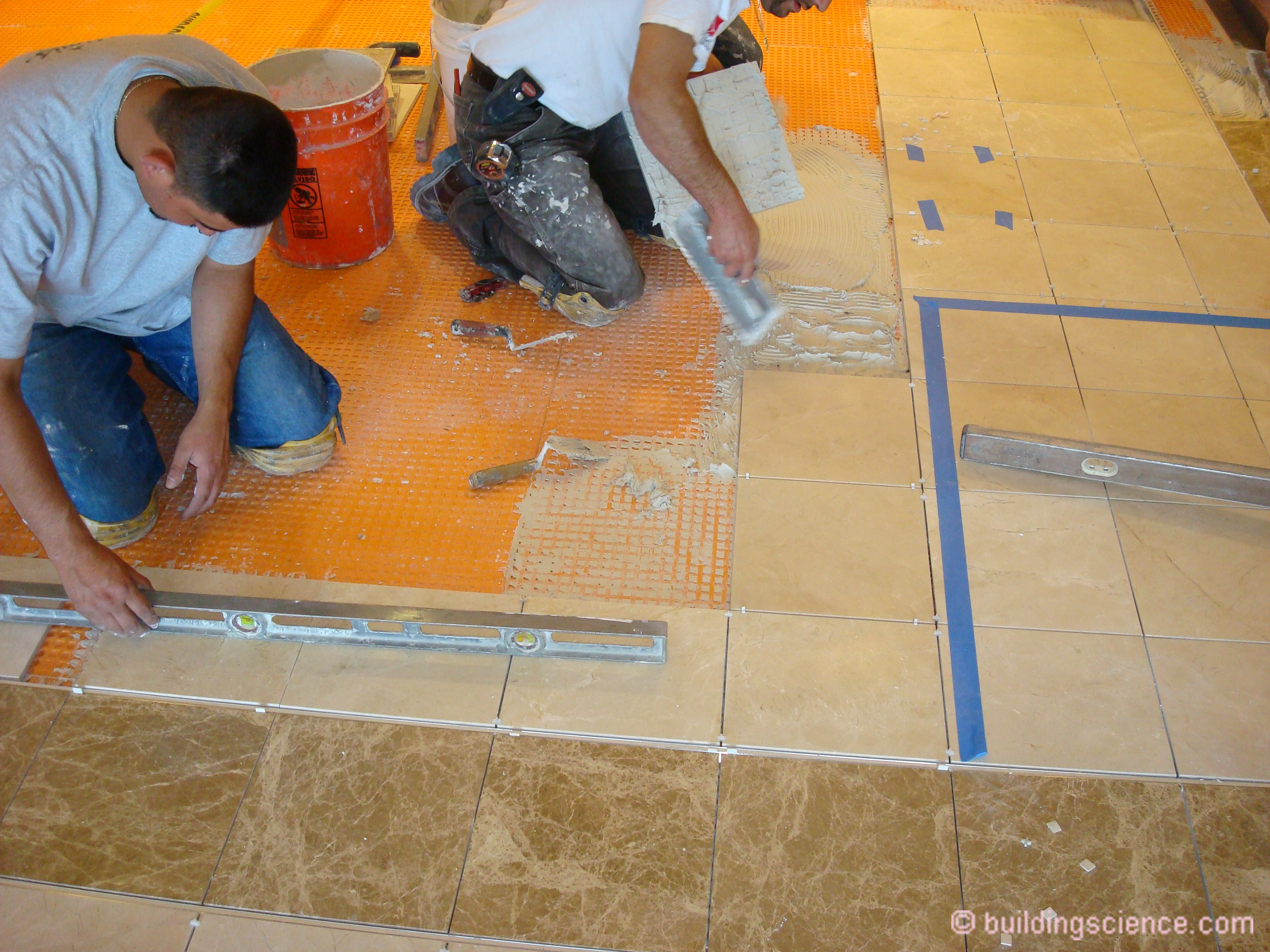
Photograph 9: Distributed Thermal Mass – Tile flooring…who knew…real impact on increasing the “time constant” of a “light and tight” well insulated frame house.
As I mentioned at the beginning we are going through a bunch of significant fundamental changes in the way we build buildings. And I do think we are getting serious about energy efficiency. We are getting serious about transitioning off of oil, coal and natural gas. The transition to electric heating and cooling is happening. The stress on the energy grid is real. We are going to have to be very serious about thermal performance. We might have to get serious about grid thermal storage. Serious means not making things up. Gimmicks do not work. Let me repeat, once again, radiant barriers do not have R-value. There is more, reflective insulation is different from radiant barriers. Reflective insulation relies on enclosed air spaces to have any benefit. There is more. Thermal mass to be effective needs to be distributed and coupled to the energy source and the space. Thermal mass is not insulation. Oh, yeah, and we are going to need lots of insulation…real insulation.
References:
ASTM C1313-19, 2019, Standard Specification for Sheet Radiant Barriers for Building Construction Applications.
ASTM C1363-19. 2019, Standard Test Method for Thermal Performance of Building Materials and Envelope Assemblies by Means of a Hot Box Apparatus.
ASTM C1371-15, 2015, Standard Test Method for Determination of Emittance of Materials Near Room Temperature Using Portable Emissometers.
Levins, W.P. and M.A. Karnitz; Cooling Energy Measurements of Single-Family Houses With Attics Containing Radiant Barriers in Combination with R-11 and R-30 Ceiling Insulation, Report ORNL/CON-226Oak Ridge National Laboratory, 1987.
Levins, W.P. and M.A. Karnitz; Heating Energy Measurements of Single-Family Houses With Attics Containing Radiant Barriers in Combination with R-11 and R-30 Ceiling Insulation, Report ORNL/CON-226Oak Ridge National Laboratory, 1988.
Schick, W.L., Jones, R.A., Harris, W.S., and Konzo, S.; Details and Engineering Analysis of the Illinois Lo-Cal House, Technical Note 14, University of Illinois, Urbana, IL, 1979.
The Effective Thermal Resistance of Foil-Faced Bubble Insulation and Other Similar Products Recognized by Natural Resources Canada for the Purpose of Modeling Homes under its Energy Efficiency Housing Initiatives, Natural Resources Canada, March 2007.
Solar V: https://libguides.mit.edu/c.php?g=175920&p=1160874
D. Anderson, Seal and Insulate with Energy Star, United States Environmental Protection Agency, Office of Air and Radiation, March 26, 2012.
Footnotes:
* Only folks from my generation…grandparents….recall one of the greatest scientific frauds of the last century…I leave it to you youngsters to look it up…hopefully in a book…found in a library…obtained from a librarian…involving a social interaction…
2 I think I got them all…oops, forgot about Gloria Vanderbilt ground up blue jeans…the ones with borates….
3 Those poor misguided Passive House folks with their 12 to 14 inch thick double wall R-50 walls should have just used 1/16 inch of reflective plaster…
4 Did you know that if you use two layers of 1/4 inch thick bubble wrap with two airspaces of minimum thickness 4.75 inches in floor joists you get R-21? Yup, right from the packing slip from the roll you buy at the lumber yard under the “Read this before you buy – what you should know about R-values” information. This needs to go in the ASHRAE Handbook’s because the ASHRAE Handbook’s clearly do not understand the physics…
5 Didn’t we go through the “mass-and-glass thing” in Santa Fe, NM in the 70’s….and who can forget the Trombe Wall…
6 Spring Breakers take note of why you are uncomfortable in your hotel rooms…and by the way enjoy the mold smell….
7 Imagine that…much like a double glazed window with an airspace and low-e coatings….
8 My Dad, the grumpy engineer he was, commented…”Why would you want to live inside a candle? Make the house wear a sweater….” I miss you Dad…and yes, I am your kind of grumpy….
